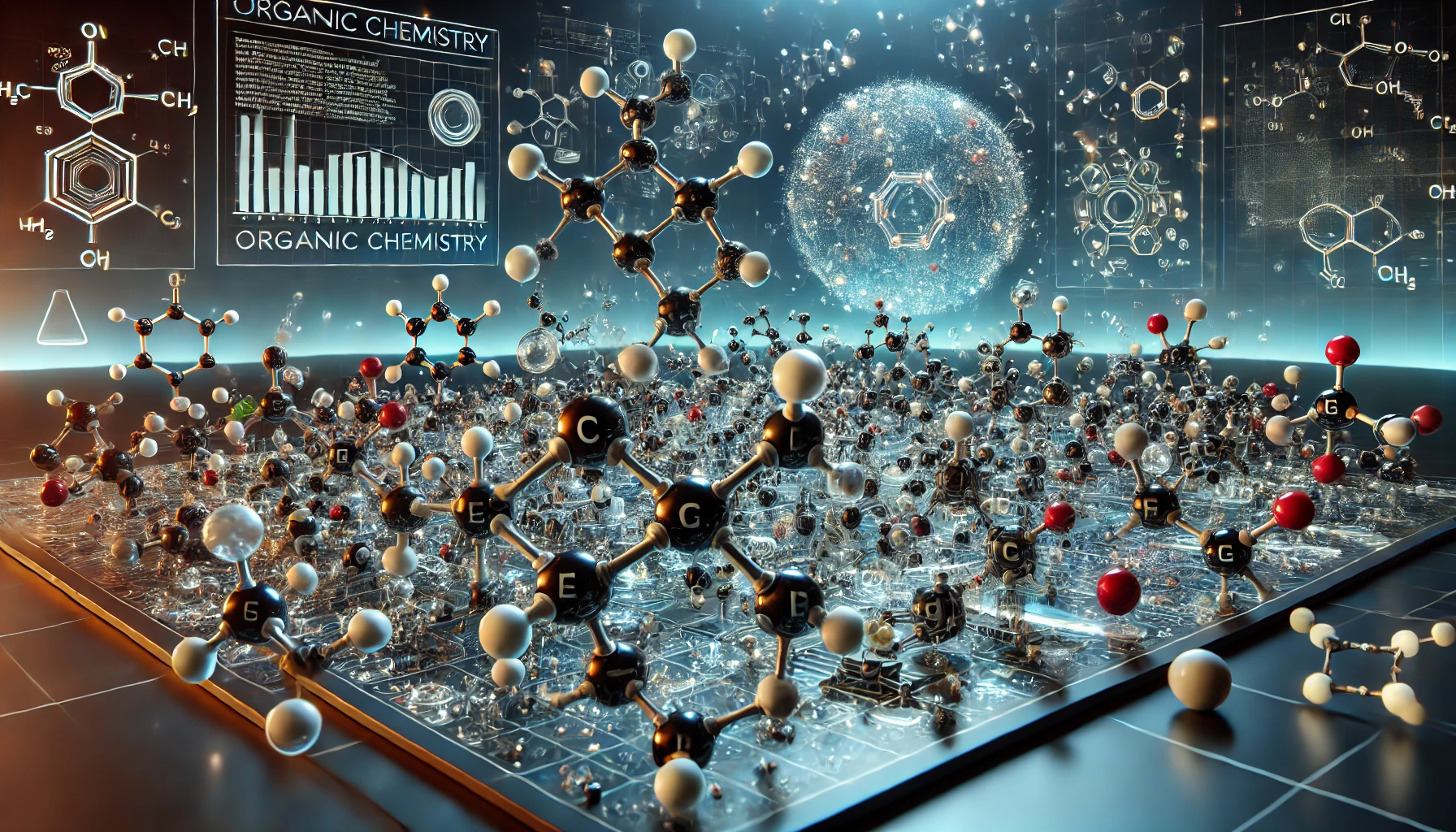Organic chemistry is the branch of chemistry, which specializes in the study of carbon-containing compounds. The said compounds include carbon, hydrogen, oxygen, nitrogen, sulfur, and phosphorus. Organic chemistry is a very broad field that widely ranges in all substances, from the most natural compounds made in plants and animals to synthetic materials created in laboratories.
- The field discovers the role played by carbon in forming a complex set of essential molecules for life.
- It ranges from medicines to plastics, both organic and synthetic.
- The basics are handy in many industries: pharmaceutical, agricultural, etc.
- Organic chemistry nomenclature is a systematic naming of compounds that shows the reader or listener their structures.
- Organic chemistry reagents are substances used to cause chemical reactions so that the new compounds can be synthesized.
| GS Paper | General Studies Paper III |
| Topics for UPSC Prelims | Basics of organic chemistry, Types of organic compounds |
| Topics for UPSC Mains | Importance in daily life, Role in agriculture, Applications in industries |
What is Organic Chemistry?
Organic chemistry is the study of carbon-containing compounds and their reactions. Carbon is unique in its ability to form strong bonds with itself and other elements, creating an almost infinite variety of molecules. The versatility of carbon is the foundation of this field of chemistry, enabling the existence of millions of different organic compounds. Organic compounds are the building blocks of life. They include carbohydrates, proteins, lipids, nucleic acids, and many others that make up living organisms.

General Organic Chemistry and Its Significance
General organic chemistry refers to the fundamental concepts and principles that form the basis of organic chemistry. It includes topics like chemical bonding, hybridization, and molecular structures. Understanding these concepts is crucial because they help explain the reactivity and behavior of organic compounds. The field is essential in streams like medicine, where it contributes to drug design, agriculture, where it aids in the creation of fertilizers and pesticides, and industry, where it is involved in the production of plastics, dyes, and detergents.
Organic Chemistry Basics
To excel in organic chemistry, one must first grasp the basics. These include:
Bonding
Carbon is remarkable because it can form four covalent bonds with other elements, creating stable and complex molecules. It bonds with elements like hydrogen, oxygen, nitrogen, and more. Such bonding flexibility allows carbon to form chains, rings, and branches, leading to the vast diversity of organic compounds that we see, from simple hydrocarbons to intricate biomolecules.
Hybridization
Carbon atoms can form various bond types, including single, double, and triple bonds, through a process called hybridization. The three main types are sp, sp2, and sp3 hybridization. It affects the molecule’s shape, bond angles, and reactivity. Understanding hybridization is crucial for predicting how carbon-based molecules interact in different chemical reactions.
Functional Groups
Functional groups are specific groups of atoms within molecules that determine their chemical properties. Examples include alcohols (-OH), carboxylic acids (-COOH), and amines (-NH2). These groups define how a molecule will react in a chemical process. Identifying and understanding functional groups is essential for predicting the behavior of organic compounds in various reactions.
Resonance
Resonance occurs when a molecule can be represented by multiple valid structures. It helps in understanding the stability and reactivity of organic compounds. For example, benzene’s resonance structure explains its unique stability despite having double bonds. Grasping resonance is key to mastering organic chemistry, as it influences how molecules interact in chemical reactions.
Isomerism
Isomerism describes compounds with the same molecular formula but different structures and properties. There are various types of isomers, including structural isomers (differing connectivity) and stereoisomers (differing spatial arrangements). Understanding isomerism is vital because different isomers can have vastly different physical and chemical properties, impacting their uses and functions in various applications.
Organic Chemistry Nomenclature
Organic chemistry nomenclature is a systematic way of naming organic compounds. It helps in identifying compounds based on their structures. The International Union of Pure and Applied Chemistry (IUPAC) provides guidelines for naming these compounds.
Naming Alkanes
Alkanes are the simplest hydrocarbons, consisting of only single bonds between carbon atoms. They are named based on the number of carbon atoms present. The naming convention involves a prefix indicating the number of carbons (meth-, eth-, prop-) followed by the suffix ‘-ane.’ Examples include methane, ethane, and propane, crucial for basic organic nomenclature.
Naming Alkenes and Alkynes
Alkenes and alkynes are hydrocarbons with double or triple bonds, respectively. Alkenes have names ending in ‘-ene,’ such as ethene (C2H4), while alkynes use the suffix ‘-yne,’ as in ethyne (C2H2). The location of the double or triple bond is indicated by numbering the carbon chain to provide a precise name for these compounds.
Naming Functional Groups
Functional groups are named by specific prefixes or suffixes based on their structure. For example, compounds containing an -OH group are named as alcohols (ethanol). Carboxylic acids have the suffix ‘-oic acid’ (acetic acid). Properly naming functional groups helps identify the compound’s properties and reactivity, making communication in chemistry precise.
Numbering Carbons
In organic nomenclature, the carbon atoms in the molecule are numbered to assign the lowest possible numbers to functional groups or multiple bonds. Such systematic numbering ensures that the compound’s name reflects its structure accurately. Proper numbering is crucial, as it distinguishes isomers with the same molecular formula but different arrangements or reactivities.

Organic Chemistry Reagents
The reagents are substances or compounds used to bring about a chemical reaction in organic compounds. They are essential in transforming molecules into desired products. Some common reagents include:
Grignard Reagents
Grignard reagents (RMgX) are vital in organic synthesis because they help form carbon-carbon bonds, a fundamental step in building complex molecules. They react with carbonyl compounds to produce alcohols, enabling the creation of a wide variety of organic compounds. This versatility makes them indispensable in organic chemistry labs worldwide.
Lithium Aluminum Hydride
Lithium Aluminum Hydride (LiAlH4) is one of the strongest reducing agents in organic chemistry. It reduces aldehydes, ketones, esters, and carboxylic acids into alcohols. Its powerful reducing ability is invaluable in synthetic chemistry, where converting one functional group into another is necessary for constructing complex molecules.
Sodium Borohydride
Sodium Borohydride (NaBH4) is a milder reducing agent than LiAlH4. It selectively reduces aldehydes and ketones to alcohols without affecting other functional groups. It selectivity makes NaBH4 a useful tool in organic synthesis, especially when working with complex molecules that require precise modifications.
Acid and Base Catalysts
Acid and base catalysts, such as sulfuric acid (H2SO4) and sodium hydroxide (NaOH), are commonly used in organic reactions to accelerate chemical processes. Acids donate protons (H+), while bases provide hydroxide ions (OH-), promoting various reactions. Catalysis is crucial in the field for efficient synthesis and maximizing yields.
Pioneers of Organic Chemistry
The father of organic chemistry is often considered to be Friedrich Wöhler. In 1828, he synthesized urea, an organic compound, from inorganic materials. The discovery shattered the belief that organic compounds could only be made by living organisms. It paved the way for the development of the field as a scientific discipline.
In modern times, many scientists have contributed to the field, earning titles like the god of organic chemistry. Robert B. Woodward, a Nobel laureate, is one such scientist known for his work on complex organic syntheses, including chlorophyll and vitamin B12.
Why Study Organic Chemistry?
- Pharmaceuticals: Understanding organic chemistry is vital in drug development. It allows the creation of compounds that interact with biological systems.
- Agriculture: It plays a role in developing pesticides, fertilizers, and growth regulators that enhance crop yield.
- Environment: Organic chemists study how compounds break down in nature, contributing to knowledge about pollution and its control.
- Materials: Many everyday materials, like plastics, dyes, and synthetic fibers, are products of organic chemistry.
Advanced Concepts in Organic Chemistry
While organic chemistry basics lay the foundation, advanced topics take the study further:
- Stereochemistry: It involves the study of the spatial arrangement of atoms in molecules and how this affects their properties and reactions.
- Reaction Mechanisms: Understanding how and why reactions occur allows chemists to predict product outcomes and create new compounds.
- Spectroscopy: Techniques like NMR and IR spectroscopy help identify molecular structures by analyzing how they interact with electromagnetic radiation.
Tips to Master Organic Chemistry
- Practice Nomenclature: Learning organic chemistry nomenclature is essential for identifying compounds and understanding reactions.
- Understand Mechanisms: Memorizing reactions is not enough. Grasp the underlying mechanisms to predict how reactions occur.
- Use Models: Physical models of molecules can help visualize complex structures and understand stereochemistry.
- Study Reagents: Knowing organic chemistry reagents and their applications simplifies understanding synthesis processes.
Conclusion
Organic chemistry is a fascinating science focused on studying carbon compounds, the basis of life. From basics to advanced reactions, it offers endless opportunities for discovery. Pioneers like Friedrich Wöhler and Robert Woodward shaped its development. The field plays a vital role in drugs, pesticides, and industry, advancing technology and improving life. It’s essential for understanding the molecular world around us.
| Organic Chemistry UPSC Notes |
| 1. Organic chemistry studies carbon compounds, including natural and synthetic materials. It is essential in medicine, agriculture, and industry for creating useful substances. 2. Carbon’s unique bonding ability leads to diverse molecules, making organic chemistry crucial for life processes and industries like pharmaceuticals and agriculture. 3. General organic chemistry covers bonding, hybridization, and molecular structures, explaining compounds’ reactivity, aiding in drug design, and materials production. 4. Basics include carbon bonding, hybridization, functional groups, resonance, and isomerism, providing a foundation for predicting compound behavior in synthesis. 5. Organic chemistry nomenclature names compounds systematically using IUPAC rules, ensuring clear identification for research and applications. 6. Reagents like Grignard, Lithium Aluminum Hydride, and Sodium Borohydride are key tools in organic synthesis, forming bonds and facilitating reactions. 7. Friedrich Wöhler, the “father of organic chemistry,” proved organic compounds can form from inorganic materials. Robert Woodward advanced complex synthesis. 8. Organic chemistry is crucial in drug development, agriculture, environment, and creating materials like plastics, influencing many sectors. |



